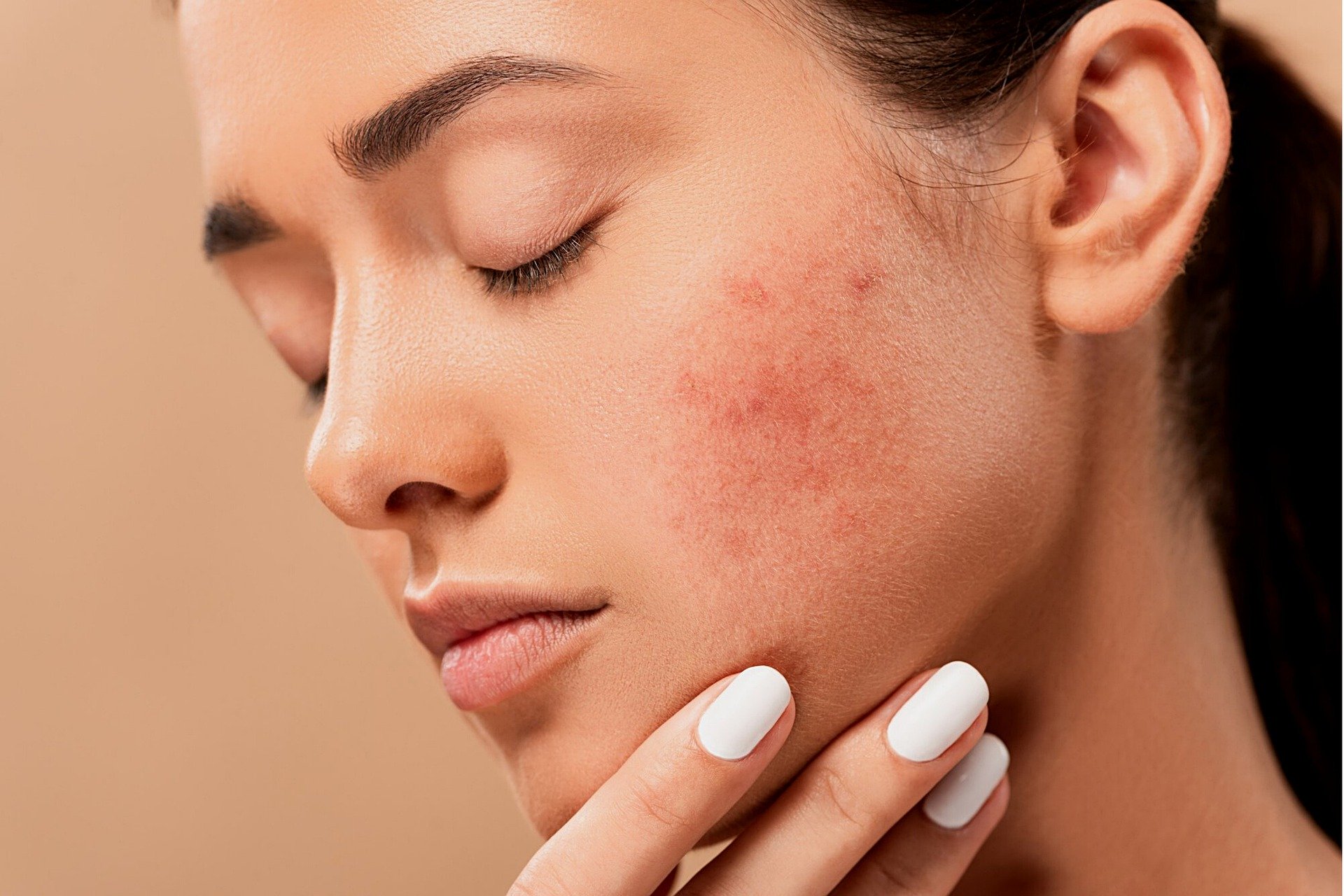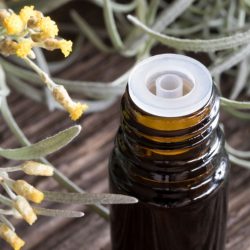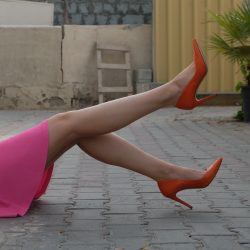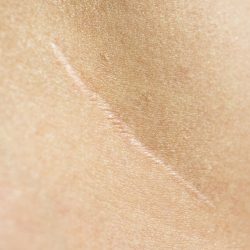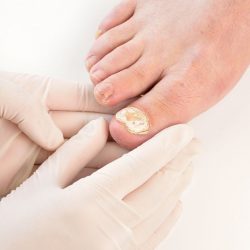After summer and exposure to the sun, teenagers– but not only teenagers – sometimes suffer from acne flare-ups a few weeks after returning from their holidays.
What causes acne?
Acne is a complex, multifactorial dermatological condition, often perceived as a simple inflammatory skin reaction, but its origins are much more complex. Among the main causes of acne, stress and hormonal fluctuations play a major role.
Stress, a common phenomenon in modern society, plays a key role in the onset of acne. In stressful situations, the human body reacts by increasing the production of cortisol, the stress hormone. This excess cortisol has a direct effect on the skin’s sebaceous glands, causing excessive stimulation. In response, the sebaceous glands produce more sebum, an oily substance which, in excessive quantities, can clog the skin’s pores, creating an environment conducive to the development of acne.
Hormonal fluctuations are also a determining factor in the appearance of acne symptoms, particularly during adolescence, pregnancy or the menstrual cycle. These hormonal variations, particularly in androgens, male hormones present in both men and women, can lead to an overproduction of sebum.
In addition to these factors, other factors can contribute to the appearance or worsening of acne. These include genetic factors, diet (particularly excessive consumption of dairy products or foods with a high glycaemic index), the use of certain cosmetics or medicines, and environmental factors such as pollution and humidity.
What is the purpose of sebaceous glands?
The skin is made up of 3 layers: the epidermis, the dermis and the hypodermis.
The dermis contains the tactile nerves, the sweat glands and the sebaceous glands.
The function of the sebaceous glands is to produce sebum, an oily, toxic substance whose primary purpose is to waterproof the skin, protect it from microbes and prevent it from drying out.
However, this sebum is then stored in your pores, where bacteria are trapped. When the pore bursts under the skin, it causes inflammation around the affected area, forming a cyst on the surface.
As a result,acne is a common, chronic dermatological condition of the pilosebaceous system (which includes the hair follicle, the hair shaft and the sebum-secreting sebaceous gland at the root of the hair).
It generally occurs in adolescence and is linked to the hypersecretion of sebum (hyperseborrhoea) and to keratinisation abnormalities leading to obstruction of the excretory canal of the pilosebaceous follicle, and the formation of comedones.
These so-called ” retention lesions” can be complicated by inflammation, secondary to an anaerobic bacterium in the skin flora, Propionibacterium acnes, which proliferates in the sebum. This often chronic condition is considered to require induction treatment, followed by follow-up and possible maintenance treatment.
Does diet play a role in acne?
Diet plays a very important role in the beauty of our skin. While some people can eat very fatty foods and have a porcelain complexion, this is unfortunately far from the rule.
When we eat ‘anti-acne‘ foods, it’s also important to avoid high-GI foods, which encourage the appearance of pimples (the glycaemic index is calculated by the proportion of carbohydrates absorbed by the body).
Here’s a list of foods to avoid if you want to keep your skin looking its best:
- Anything industrial: biscuits, pastries, etc
- Steamed potatoes, chips, mashed potatoes
- Bread (white or wholemeal)
- White sugar
- White rice
- Cooked carrots
- Cornflakes (yes!)
- Polenta
- Meat and especially cold meats should be avoided if you’re prone to pimples
- Alcohol
- Cigarettes
- Chocolate
- Crisps and all snack cakes
- Mayonnaise
- Nutella
In short, junk food in general..
But don’t worry, there are foods that are sources of vitamin B6, a perfect ally in the event of skin problems.
Vitamin B6, also known as pyroxine, helps to prevent and reduce skin problems.
It is found naturally in :
- Yeast
- Peas
- Spinach
- Broccoli
- Cabbage
- Mushrooms
It is also advisable to drink plenty of water.
An effective 100% natural recipe with essential oils:
Certain essential oils are highly effective in the fight against acne:
Tea tree essential oil:
- Major anti-infective, antibacterial (anti-infective effect through activation of white blood cells, activation of monocyte differentiation)
- Anti-inflammatory (mainly in the skin, by reducing the proliferation of cells mediating inflammation and their mediators)
- Activity on various dermatological conditions (skin and mucous membranes), such as acne vulgaris
- Anti-acne action on Propionibacterium acnes
- Present at 5% in gel form, the effect is comparable to benzoyl peroxide at 5%
Marjoram essential oil:
- Medium intensity antibacterial
- Anti-inflammatory (inhibition of pro-inflammatory cytokines)
- Anti-infectious effect through activation of white blood cells, activation of monocyte differentiation
- Antiacne effect on Propionibacterium acnes
Argan vegetable oil :
- Anti-inflammatory and antioxidant
- Anti-acne
- Skin regenerating
- Nourishing, highly penetrating
Formula idea: Dilute 0.1 ml of Tea Tree essential oil and 0.1 ml of Marjoram essential oil in a 10 ml bottle filled with Argan vegetable oil (i.e. a dilution rate of 1% for dermocosmetic action).
Mixture to be applied daily to clean, dry skin 1 to 2 times a day until symptoms improve.
Precautions for use of the formula:
- Contraindicated for pregnant or breast-feeding women and children under the age of 12
- Avoid in association with cortisone
- Not for prolonged use
- Risk of drug interactions, ask your pharmacist for advice
What are the best homeopathic remedies for treating acne?
It’s difficult to make generalizations, because homeopathy is a highly individualised form of medicine, which focuses first and foremost on the patient and the origin of the illness. That’s why it’s always best to seek the advice of a competent pharmacist or homeopathic doctor before embarking on a course of treatment. However, certain strains are frequently used in acne treatment protocols.
Uncomplicated acne :
-
Antimonium crudum 4 to 7 CH :
For heavy eaters, or following overeating. Taken three times a day for the low dilutions, once a day for the 7 C.
-
Sulfur iodatum 7 CH :
In a cold adolescent who gets colds easily, acne on the forehead and back, 3 granules 3 times a day.
-
Arnica montana 5 CH :
When the lesions are symmetrical with a tendency to ecchymosis, especially when they are bruised. Taken twice a day.
-
Eugenia jambosa 4 to 5 CH :
This remedy is mainly used in young girls whose lesions worsen during menstruation. The skin is oily and the pustules are indurated. Taken three times a day.
-
Juglans regia 4 to 5 CH :
Acne is aggravated by fatty foods. In young girls, menstruation is early and blackish. On the digestive side, bloating is frequent. Taken two to three times a day.
-
Selenium 7 CH :
The homeopathic remedy Selenium 7 CH is often recommended in cases of acne characterised by oily skin, blackheads, hair loss and general tiredness. It is particularly indicated when eruptions worsen after exposure to the sun. There is seborrhoea; the skin has an oily appearance. It is dotted with blackheads.
Suppurating acne :
Arnica montana is widely recognised in homeopathy for its anti-inflammatory and healing properties. In the context of suppurative acne, characterised by the formation of pustules and noticeable inflammation, Arnica montana 7 CH is often recommended for several key reasons:
- Reducing Inflammation: Arnica montana has properties that help to reduce skin inflammation, a common symptom of suppurative acne.
- Accelerated healing: In homeopathy, Arnica is considered to promote the healing of damaged tissue. This can be particularly useful in cases of suppurative acne, where the skin is often irritated and damaged by pustules.
- Antiseptic effect: Although Arnica is not an antiseptic in the traditional sense, it is thought to help cleanse the skin from within, helping to manage bacterial infections associated with acne.
- Pain Reduction: Suppurative acne can be painful due to inflammation and pus build-up. Arnica is known for its analgesic effects, which can help relieve this pain.
- Improved local circulation: Arnica is also known to improve local blood circulation. Improved circulation can contribute to better oxygenation and nutrition of the skin, which is beneficial for skin health and can help reduce the appearance of acne.
-
Arnica montana 7 CH :
Take once a day.
-
Hepar sulfur :
When the acne is highly inflammatory and the pus draining from the lesions is bloody and foul-smelling. We do not give a dilution for this remedy, as it can be tricky to handle. Used in low dilution, it will encourage suppuration and accelerate healing; in high dilution, it dries out the lesions and slows the formation of pus.
-
Silicea 4 to 15 CH :
For long, cold people. In low dilution, it promotes healing, prevents superinfections and remineralises the body. Taken twice a day. A weekly dose of 15 CH may be added to optimise its action, provided that the general signs are present.
-
Sulfur 9 CH :
This homeopathic remedy is often highly effective, provided the general signs are present, but it should only be prescribed by a doctor, as the risk of aggravation following its use is not negligible. It is generally preferred to Sulfur iodatum 9 CH, which is easier to use.
Scarring and micocystic acne:
Can homeopathy reduce the scarring of acne pimples?
Taking 5 granules of Antimonium Tartaricum 4 CH daily, in addition to treatment, can help prevent acne scars, as well as chickenpox scars.
-
Baryta carbonica 4 to 7 CH :
Scars are sclerosed, the skin is atrophied, indurated and sometimes retracted.
-
Kalium bromatum 9 CH :
The cysts are indurated; other signs should justify the use of this homeopathic remedy, in particular restlessness of the hands.
-
Tuberculium residuum 9 CH :
Tuberculium residuum homeopathic treatment is generally used on scar lesions are indurated; lymph nodes are frequently found. Lesions are also present on the back.
-
Luesinum 9 CH :
The homeopathic remedy Luesinum 9 CH is recommended when the lesions are extremely large and disfiguring; they tend to ulcerate.
Homeopathic consultation: the essential step
If you want to treat your acne with homeopathy, the first step is to consult a specialist. “Like any doctor, the homeopath will examine your skin to determine the type of acne you are suffering from. However, this examination will be supplemented by a questionnaire designed to get a better idea of your personality, your lifestyle and your current state of mind,” explains homeopathic dermatologist Dr Philippe Louis. “Homeopathy is a medicine that takes the whole patient into account. So attention is paid to both the physical and psychological aspects of the patient The treatment that the homeopath prescribes will therefore vary not only according to the type of acne you have, but also according to the psychological particularities that make you an individual in your own right.
Homeopathy: finding the right acne treatment
- Tuberculin,
- Thuja,
- Baryta Carbonica,
- Hepar Sulfur,
- Natrum Muriaticum,
It can sometimes take some time to find the right treatment. “With a bit of luck, the first prescription is effective,” says Dr Louis. “But in some cases, the homeopath will have to test several active ingredients, one by one, over a period of 6 weeks. So you have to stick with it and not give up too quickly. Because once you’ve found the right remedy, the therapeutic effect is excellent!
What are the most common homeopathic responses to juvenile acne?
I often recommend taking 3 granules of Kalium Bromatum 9 CH in the morning and 3 granules of Eugenia Jambosa 4 CH in the evening, followed every Sunday by a dose of Natrum mur 15 CH alternating with Sulfur Iodatum 15 CH, also for 3 or 4 months. Adolescents undergoing conventional allopathic treatment can also reduce the undesirable effects, particularly dry skin, by taking 3 granules of Natrum Mur 9 CH 3 times a day.
For blackheads or excess sebum, is it necessary to take a complementary treatment?
Of course. It is possible, for example, to treat excess sebum with 3 granules of Selenium 5 CH morning and evening in combination with the anti-acne duo Kalium Bromatum and Eugenia Jambosa mentioned earlier.
What about treating adult acne?
It all depends on the cause. The treatment will differ depending on whether the acne is linked to the menstrual cycle, stress or genetics. But taking a dose of Natrum Mur 15 CH every Sunday, alternating with a dose of Tuberculinum Residuum 9 CH, is generally quite effective. Acne rosacea is best treated with Sanguinaria Canadensis 5 or 7 CH 3 times a day.
Can the sun cure acne?
The sun has a significant impact on acne in several ways. On the one hand, moderate exposure to the sun can temporarily improve the appearance of acne by drying out pimples and helping the skin to develop a more even tone. In addition, the sun stimulates the production of vitamin D, which is essential for healthy skin. However, excessive exposure to the sun can be counter-productive. The sun can dry out the skin, leading to increased production of sebum, which can worsen acne. What’s more, UV damage can cause the skin to thicken, blocking pores and encouraging the appearance of blackheads. It is therefore crucial to strike a balance in sun exposure and use adequate sun protection to manage acne.
Source:
- Interview with Dr Philippe Louis, homeopathic dermatologist.

